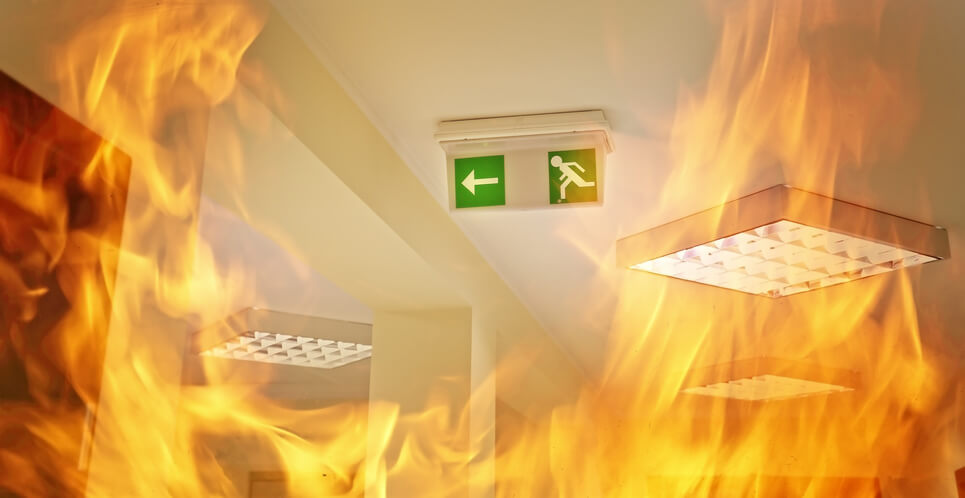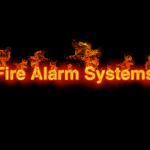By law, every block of flats and all business premises is required to conduct a fire risk assessment. However, not everyone has a good understanding of this essential fire safety measure.
People often ask, “what is a fire risk assessment?” A fire risk assessment needs to be at the center of your building’s fire safety plans.
Fire risk assessments, unfortunately, are frequently overlooked. This can result in buildings being unnecessarily exposed to fire risk, and potentially loss of life at times.
What is a Fire Risk Assessment?
A fire risk assessment is a review undertaken of a building in order to assess its fire risk and offer recommendations to make the building safer, if necessary.
If there are less than 5 occupants regularly in the building, then it isn’t required for the fire risk assessment to be written down. So it isn’t always a document.
We do, however, recommend that a fire risk assessment always is in writing, since that is the easy way for the findings to be communicated and to ensure that any recommendations are carried out.
Are there any legal guidelines associated with fire risk assessments?
Fire risk assessments do have some specific guidelines.
The Fire Risk Assessment must be reviewed on a regular basis. It is recommended that the following be included in the review:
- Every 12 months after the original assessment is done
- Every 5 years a new assessment should be conducted
- If the building’s purpose has substantially changed
- If the building structure, such as the layout, has changed
- If there has been a considerable change in the occupants
Changes to a building’s layout, how it is used, or the kind of occupants using or living in the building can significantly impact your fire safety plans. Therefore it is very important that a review of your fire risk assessment be conducted if any of those have occurred.
If there are 5 regular occupants or more the fire risk assessment must be in writing.
If your block of flats or business premises normally has over 4 residents at once, then you are legally required for your fire risk assessment to be documented.
As mentioned previously, it is recommended that your assessment is in writing, no matter what size your premises are.
There are a few other situations where you will be required to have a written fire risk assessment even when having less than 5 regular occupants. They are:
- You have been instructed to do so by the fire brigade (for example, after a visit)
- If your premises are required to have a licence
The main findings and actions to be taken must be recorded.
Whether or not it is written down, a fire risk assessment has 2 parts that must be generated.
The first part is the actual review, which assesses the premises fire safety against several points.
The second part is a list of requirements that should be acted upon in order for the build to be in compliance with fire safety measures.
It is very important for these recommendations to be acted on since that is what keeps your building safe ultimately.
Who is responsible to ensure that a Fire Risk Assessment is conducted?
By law, every block of flats and business is required to have an individual who is designed as the “Responsible Person” who is responsible for the building’s fire safety.
The job of the designated Responsible Person is to ensure that all relevant fire safety tasks are conducted and that any necessary action is taken in order to prevent fires from occurring and to prevent death or injury if a fire takes place.
The responsible person is, therefore, the one who needs to ensure that a valid fire risk assessment is made on your building.
Small business owners are usually the Responsible Person for their premises unless someone else from the team is nominated.
For tower blocks and blocks of flats, the Responsible Person is usually the managing agent or landlord, although it can be a Residents’ Association member as well.
The Responsible Person in blocks of flats is only responsible for common areas, like stairwells and corridors. Residences are responsible for ensuring that their own flats are safe from fire.
How can I obtain a copy of the Fire Risk Assessment for my building?
As a building occupant, you have the right to access to the Fire Risk Assessment for the premises if you want it.
You should first contact your building’s Responsible Person. If you are unsure who that is, then good places to start would be the business owner, managing agent, landlord or facilities department.
If you discover that there is no valid fire risk assessment for your building, then you should ask the Responsible Person to have one conducted right away.
If you feel your concerns are not being treated seriously by the Responsible Person for your building, then you contact the local fire and rescue service as your last resort.
However, the fire and rescue service should not be contacted over trivial concerns, since they are very busy. The 999 emergency number should also not be used. You should be able to find the general enquiries number for the local fire brigade online.
What is reviewed as part of a fire risk assessment?
Fire Risk Assessments should be comprehensive and numerous fire risk factors should be taken into account.
The amount of detail included in an individual review depends to a great extent on the building’s complexity. For example, a one compartment building, like a kiosk or small shop, is going to have a lot less that needs to be reviewed compared to a block of flats or large office block.
Although every fire risk assessment is unique, the following fire prevention and fire risk factors should be checked by the assessor as part of the assessment:
- The building’s construction, layout, and use
- The nature and number of occupants, including any potentially vulnerable occupants
- Electrical equipment on the site that could be a potential source of ignition
- Whether the building has a history of any fire loss
- Defense against arson
- Smoking areas as well as prevention measures that have been taken to prevent fires caused by smoking
- Protection against fires that are caused by lighting
- Installed and portable heating devices that can trigger fires
- Any fire hazards that have been introduced by outside contractors or building works
- General housekeeping and key areas being kept clear of any combustible materials
- The configuration and maintenance of escape routes
- Storage arrangements for any flammable and dangerous liquids
- Emergency lighting has been properly installed and is in good working order
- Measures are in placed for limiting fire spread
- Adequate means are in place to raise the alarm in the event of a fire
- Fire safety signs are in the proper locations and used correctly
- Other devices, like sprinklers, are properly installed and maintained
- The appropriate fire extinguishers are in the correct locations
- Whether or not there is evacuation drills and fire safety training on a regular basis
- Who manages the building’s fire safety and how well it is done
- Proper records and documentation are being kept on fire safety measures
- Correct testing procedures and maintenance are in place for fire safety systems
Who can conduct a Fire Risk Assessment?
According to legal guidelines, a fire risk assessment may be conducted by a “competent” individual. That doesn’t necessarily mean that a qualified Fire Risk Assessor must be used.
However, what it does mean is that whoever does conduct your fire risk assessment must be comfortable with assessing your building or premises against all of the different factors that are listed above.
They also need to be able to do the following:
- Record all of their significant findings in detail and clearly
- Get a fire safety action plan developed if any changes are necessary and record those actions in writing
- Get the action plan implemented if one is necessary
- Update the fire risk assessment continuously
A professional fire risk assessor undergoes lots of detailed training and is fully versed in all of the most recent guidelines and legal requirements, including how they should be applied to different kinds of buildings.
What is the penalty for failing to have a fire risk assessment?
If you do not have a fire risk assessment and, specifically do not have the proper fire safety precautions in place, the penalty is prosecution that results in severe fines. The penalty can be a prison sentence in extreme negligence cases.




